


It seems like a good bet that the car movie will always be with us. Of course, a “car movie” can mean many things — from a racing flick to a road movie to, well, a film that’s just set among cars in general. Regardless, let’s take a step back and look at some of the best car movies over the years, and do so in an all-encompassing, inclusive way. This list of movies is quite eclectic — it includes gearhead classics, cult standbys, noirs, modern blockbusters, art-house favorites, and even some genuine obscurities. Along the way, it became clear to us that a “car movie,” more than anything, is a film where a car plays a key role in the way a character interacts with the world — be it as a weapon, a tool, a dream, a setting, or a metaphor. Here are the 38 greatest car movies. (And as usual, we’ve stuck to one film per franchise, lest you wonder why there aren’t half a dozen Fast and Furious movies on this list.)

Shootouts with bad guys, exotic locations, beautiful women, fast cars -- what man hasn't fantasized about stepping into James Bond's shoes for a day? We've been watching James Bonds movies since the introduction of the franchise in 1962, and we've been enamored with 007 ever since.
One of the most iconic aspects of any James Bond movie is the various cars that make their way onto the big screen. From the Lotus Esprit featured in The Spy Who Loved Me to the clunky yet functional Bajaj RE featured in Octopussy we're removing the car covers and revealing a complete list of every vehicle driven by 007 in chronological order.
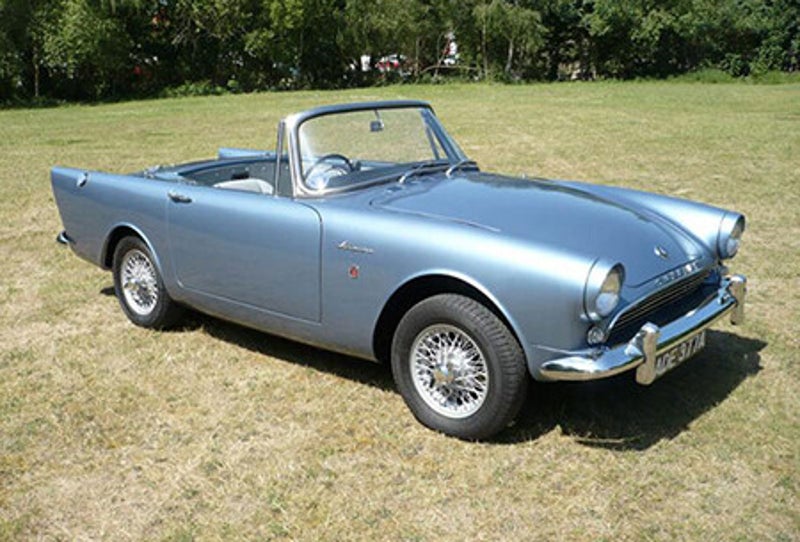
dr. no (1962)
It all began with Dr. No, the first Bond movie ever that premiered in 1962. He drove the Sunbeam Alpine Series II which sported a lake blue coat of paint. In classic 007 fashion, the super spy is lured to the apartment of Miss Taro, an enemy spy. As he drives up a mountainside for a "heart to heart" with Miss Taro, he's ambushed.
A car chase soon ensues, but Bond's expert driving skills sees him free of his pursuers as they go tumbling down the mountain in a fiery crash. The English made Sunbeam Alpine was manufactured in jolly old England, a tradition that many Bond cars would follow in the coming years.

goldfinger (1964)
Ask any James Bond fan about the top five most iconic 007 cars and the DB5 will most certainly make its way to the top of the list every time. In terms of recognition, the Aston Martin DB5 has been greatly popularized by the sheer number of movies that it has been featured in. Of course, 007's version is equipped with machine guns, tire slashers, an ejection seat and many other nifty little gadgets. The DB5 was so popular that it was featured in a medley of Bond films that include Thunderball, Goldeneye, Tomorrow Never Dies, Casino Royale, and Skyfall.

on her majesty's secret service (1969)
The fifth Bond film temporarily did away with Sean Connery and introduced second Bond actor, George Lazenby. The DBS would play a tragic role in this movie. As Bond and his wife are driving in the DBS, she's assassinated through the windshield. The Aston Martin DBS was the latest edition at the time and would make a brief appearance in the next film Diamonds Are Forever as it's being equipped with missiles in the infamous lab of Q.

the spy Who loved me (1977)
The Spy Who Loved Me was one of the most exciting Bond films, due in part to the Lotus Esprit S1. As usual, Bond is on the run from the bad guys. With Barbara Bach riding shotgun, Bond has to outrace bad guys on the ground who aren't making his escape easy.
Soon enough a helicopter joins the mix, forcing Bond to drive off a peer and dive into a lake, where, you guessed it, armed frogman lie in wait for him. The Lotus Esprit transforms into a miniature submarine and easily mops up the bad guys both underwater and in the air. The scene ends with bond driving back onto land past a group of tourists as if the entire affair never happened.

for your eyes only (1981)
Clearly, the chase scene involving the Lotus from the previous movie was exciting enough to prompt the return of the vehicle, though this time with a more supped up model. In For Your Eyes Only Bond attempts to escape from the hideout of Hector Gonzales. However, instead of getting a repeat of the amazing chase scene from The Spy Who Loved Me, one of Gonzale's goons approaches the vehicle and smashes the passenger side window.
Perhaps he should have read the "Burglar protected" sticker because the vehicle self-destructs and takes the bad guy with it -- because who doesn't protect equip their cars with self-destruct systems to scare off burglars, right?

the living daylights (1987)
The Living Daylights introduced a new 007, Timothy Dalton. Despite bringing on a new James Bond, the producers decided to bring back an old car, one that hasn't seen the light of day in a Bond film for the past 18 years, the Aston Martin. This time, Q labs goes all out in making this the most deadly Bond car to date. The Aston Martin is equipped with tire spikes, missiles, lasers, a missile guidance display, a self-destruct timer and more. Despite all of its modifications, the Aston Martin V8 looks just as beautiful as the DBS Bond drove in On Her Majesty's Secret Service in 1969. Find our car covers for your Aston Martin V8 Vantage.

goldeneye (1995)
The BMW Z3 was the first BMW that Bond has ever driven. During its introduction in Goldeneye, Bond is briefed by Q on all of the vehicle's specs -- stinger missiles, an ejector seat, and an all-points radar amongst other goodies. The BMW was ready to rule the road with Bond in the driver's seat, but the Z3 was more of a product placement rather than part of Bond's essential arsenal. He merely drives the vehicle to a waiting plane and transfers the BMW to another agent who he warns not to touch any of the buttons.

tomorrow never dies (1997)
If fans were disappointed by the fact that Bond hardly used his BMW in the last movie they were in for a great surprise in his latest outing in Tomorrow Never Dies. This time around, Bond drives a BMW 750iL, and it sports some of the most impressive weaponry and tech to date in a Bond car. With electrified door handles sledgehammer proof windows, hidden tear gas compartments, and the ability to be driven remotely by Bond's phone, the 750iL was the bane of every henchman who came across its path.
Bond displays the vehicle's impressive capabilities when he's forced to make a grand escape from a parking garage as armed thugs attempt to vandalize his vehicle. Bond escapes a hail of gunfire and trailing gunmen as he drives the vehicle from the relative safety of the backseat. He fools the trailing bad guys by bailing from the vehicle and sending it soaring from the rooftop of the parking complex and into a rental shop below.

the world is not enough (1999)
BMW had done well in terms of sales due to its product placements in the past two Bond films. The World is Not Enough was the last of these product placements and the BMW Z8 saw a fitting end during an especially harrowing air-to-ground chase scene. Bond incurs the wrath of his enemies and has a helicopter sent after him. He manages to take it down with a surface-to-air missile, but the first helicopter is soon replaced by a second, and this one is equipped with a nasty device that cleaves Bond's poor BMW clean in half.

die another day (2002)
Die Another Day takes a twist for the sci-fi due to the introduction of the Aston Martin V12 Vanquish and its ability to vanish into thin air. Well, not exactly. The Vanquish or perhaps "The Vanish" can generate an invisibility cloak that allows James to drive around virtually undetected. Of course, this hi-tech car wouldn't be complete without its usual fanfare: torpedoes, target-seeking shotguns, an ejector seat and other goodies.
Bond was doing perfectly fine sitting undetected in the ice palace of Gustav Grave. That was, until a snowmobile plows into the Aston Martin, giving away his location and initiating a chase involving a similarly supped up Jaguar. The most notable gadget on the Jaguar was its thermal imaging screen that allowed the henchmen to keep up with Bond. A seven-minute chase sequence ensues that involved missiles, rockets, machine guns, and even ejector seats.

casino royale (2008)
2008 was the year that James Bond received a makeover. The franchise was essentially rebooted, giving Bond a darker more serious tone. Daniel Craig delivered his performance of Bond with perfection, bringing the Aston Martin DBS V12 along for the ride. At this point in the series, the producers did away with the more unrealistic upgrades to 007's ride and equipped the vehicle with more realistic gadgets: a silenced Walther PPK and a defibrillator.
Bond is in hot pursuit of Le Chiffre who had just kidnapped Vesper Lynd. After cresting a small hill, he finds Vesper tied up in the road, forcing him to swerve to avoid hitting her and flipping a total of 7 times. The enemy takes advantage of the situation and move in to capture Bond.

skyfall (2012)
The DB5 first made its grand reappearance in Casino Royale where Bond wins the vehicle in a high stakes game of poker. In the latest film Skyfall, M is on the run from Raoul Silva. Stopping by a garage Bond hops out and heads to open the door. M states promptly that she would not be hiding inside of the garage to which Bond states "we're just switching cars." The garage door opens, and the Aston Martin DB5 awaits them. With the classic Bond theme playing in the background, the pair drives off for Scotland to lure Silva away from the innocents in London and to lead him into a trap. M complains that the ride wasn't terribly comfortable to which Bond playfully thumbs the ejector seat button.

1949 buick roadmaster, rain man



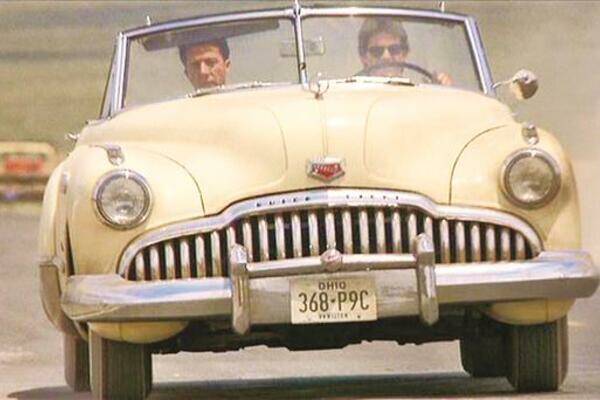
The Oscar winning 1988 film “Rain Man” starred Dustin Hoffman and Tom Cruise but for fellow car enthusiasts the true star of the film was the 1949 Buick Roadmaster Convertible. The film tells the story of an abrasive and selfish young Charlie Babbitt (played by Tom Cruise), who learns that his father has died and left his fortune to his other son, Raymond (played by Dustin Hoffman), an autistic savant.
'Cruise's Charlie Babbitt is a high-end car salesman and the 1949 Buick figures large in his life as the one car he never got to drive as he was forbidden from it by his father,' said Margaret Barrett, Director of Entertainment & Music Memorabilia at Heritage. 'Once he and Hoffman connect, they set off on a cross-country adventure in the car, which is in virtually every scene, and the rest is Hollywood history,' she says in a statement. 'This is a plum prize for the buyer,' Barrett adds. 'It's one of the great screen-featured automobiles from the 1980s, from one of the best films of the decade, besides being a prime example of one of America's greatest classic cars.'

1971 ferrari 365 replica daytona spyder /1986 ferrari testarossa/1972 de tomaso pantera



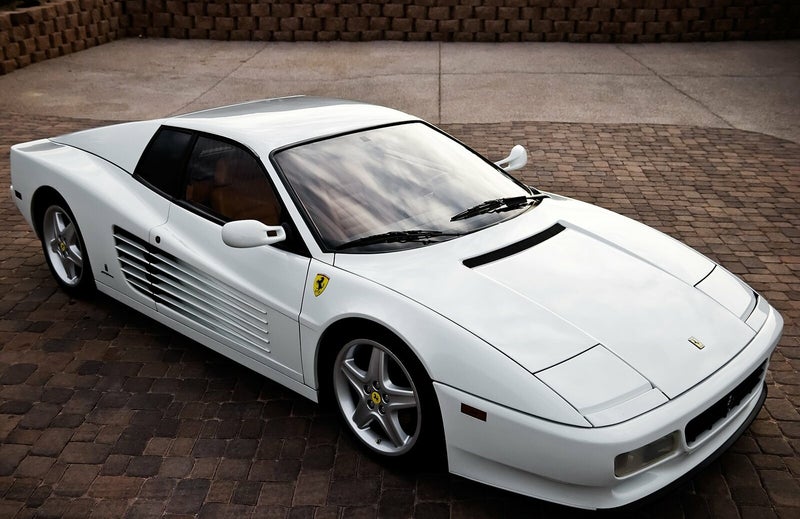
The imposter car replicated a 1972 Ferrari 365 GTS/4 Daytona Spyder. Two identical cars, built on a Corvette C3 chassis, were designed by McBurnie Coachcraft.
The first fake Ferrari was the glamour car and used exclusively for getting the infamous sexy shots that audiences came to love. The second car took a regular beating, used solely for stunt work. It included skid plates, camera rigging, and a specialized braking system. The knockoff Ferraris appeared during the first two seasons of Miami Vice. The car met its demise when an illegal arms dealer blew up Crockett’s beloved car.
While the Testarossa was introduced solely because Enzo Ferrari was outraged that a Corvette was being used to portray a Daytona, mocked-up vehicles were still used on the show even after the Testarossa's introduction, largely due to the high cost of the real Ferraris ($181,000 in 1986, compared to some $35,000 for the McBurnie Daytona Spyders used previously). As a result, a DeTomaso Pantera with a Testarossa body kit was built by Carl Roberts, the man who had acquired the two replica Daytonas after their removal from the show. This Pantera replica was used for much of the stunt driving scenes or whenever there was a risk of wrecking the real car. There was also a defect with genuine Testarossas that caused them to stall when executing high speed spins, and the use of the Pantera allowed producers to bypass this. The modified DeTomaso Pantera can be distinguished from the bona fide Testarossas in several scenes by its higher ride height, different wheels and the visible seams on its body panels.
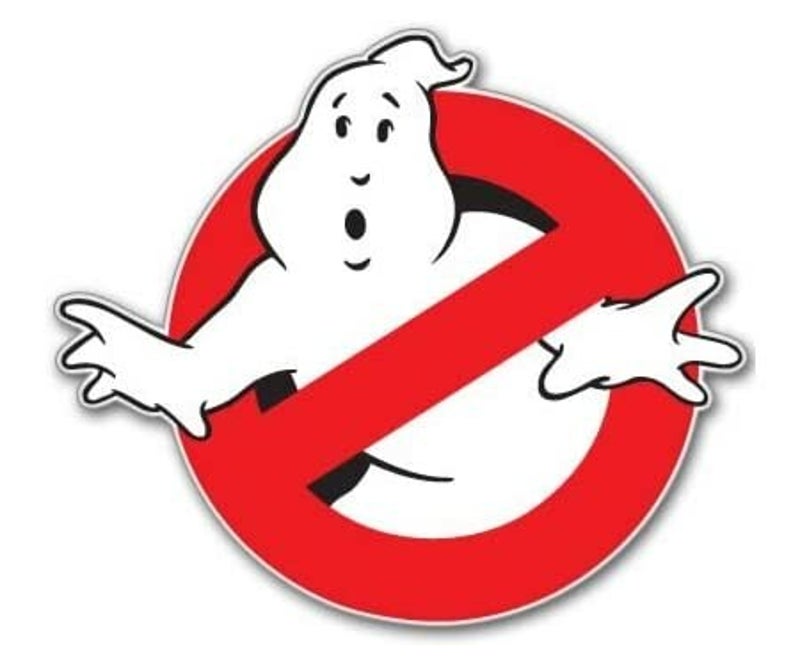
1959 cadillac miller-meteor ambulance ecto-1




Ecto-1 is the name the “Ghostbusters” gave their odd, now-iconic Cadillac featured in the 1984 film.The car,heavily modified for the movie, was strange enough looking even without the added lights, sirens, and fantastical detection hardware on the roof – the 20-foot long, 6,500-pound 1959 Cadillac Miller-Meteor ambulance had huge tail fins and a massive front end bearing multiple lights and a big, shiny grill.
The Ectomobile, or Ecto-1 is a 1959 Cadillac Miller-Meteor Futura Duplex limo-style endloader combination car (ambulance conversion) used in the 1984 film Ghostbusters and other Ghostbusters fiction. The original vehicle design was the creation of Steven Dane, credited as a Hardware Consultant in the credits.
For the first two Ghostbusters films, Sony used three different 1959 Cadillac Miller-Meteor hearses: one that portrayed the wreck that Ray Stantz bought, one that portrayed Ecto-1 in the 1984 film, and a third that starred as Ecto-1A in the 1989 sequel, the latter two designed by Stephen Dane.
Fun Fact: Dan Aykroyd's original Ecto-1 was an all-black, sinister-looking vehicle with flashing purple and white strobe lights that gave it an eerie ultraviolet aura. While reviewing the script, the cinematographer Laszlo Kovacs initially pointed out the black design would be a problem since part of the movie would be shot at night.
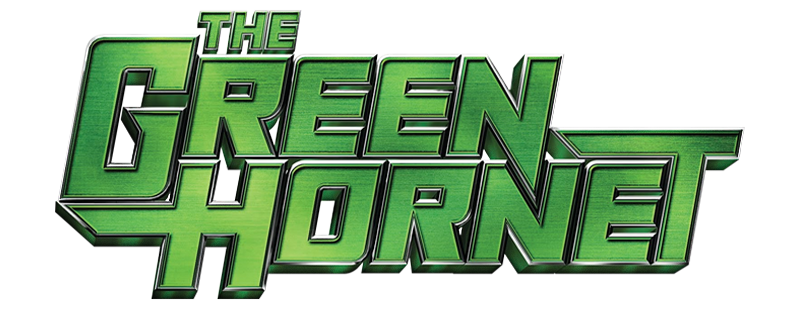
2011 black beauty, green hornet




The Green Hornet was a superhero comedy that never really made a mark, which is a shame considering the elaborate history of the Green Hornet character. One of the coolest aspects of the 2011 film, however, was definitely the Hornet’s car, dubbed the Black Beauty. It’s driven by his chauffeur, Kato, and this jet black Chrysler Imperial packs a wallop.
It comes equipped with two .30 caliber machine guns, front-mounted missiles, a flamethrower, headlight shotguns, rear-mounted missiles, rear machine guns, door guns, anti-riot spikes, interior rifle mounts, and more! Needless to say, even though it probably was meant to be a parody on over-the-top superhero cars, the Black Beauty is quite a stunner.

1973 ford falcon xb gt pursuit special

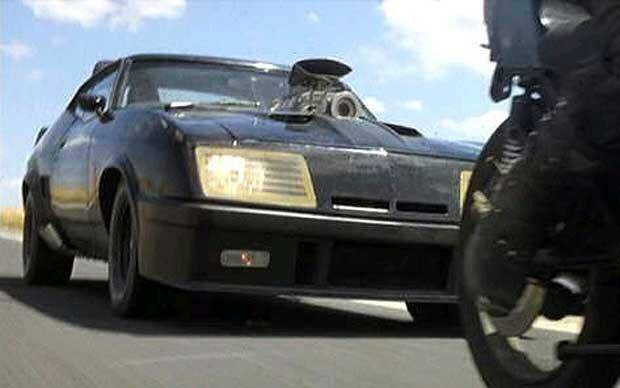


The Pursuit Special, also referred to as the Last of the V8 Interceptors, is the iconic black GT Falcon muscle car featuring a distinctive supercharger driven by the title character Mad Max during much of the Mad Max franchise, where it appears in Mad Max, Mad Max 2: The Road Warrior and in Mad Max: Fury Road, as well as both video games. The vehicle started out as a standard white 351 cu in (5.8 L) Australian built 1973 Ford Falcon XB GT Hardtop when in 1976, filmmakers Byron Kennedy and George Miller began preproduction on Mad Max. The movie's art director Jon Dowding designed the Interceptor and commissioned Melbourne-based car customizers Graf-X International to modify the GT Falcon. Peter Arcadipane, Ray Beckerley, John Evans, and painter Rod Smythe transformed the car as specified for the film.
Against the odds, “Mad Max” became a cult classic that spawned multiple sequels, remakes, video games, and launched the career of Mel Gibson. And the modified 1973 Ford Falcon XB GT featured in the film has also cemented in its place in culture.

1983 gmc vandura, the a-team




The black and metallic grey GMC Vandura van used by the A-Team, with its characteristic red stripe, black and red turbine mag wheels, and rooftop spoiler, has become an enduring pop culture icon. One of the original six vans used for the show is displayed in the Cars of the Stars Motor Museum in Keswick, northern England. Early examples of the van had a red GMC logo on the front grille, and an additional GMC logo on the rear left door. Early in the second season, these logos were blacked out, although GMC continued to supply vans and receive a credit on the closing credits of each episode. In many stunts where the van would surely be totaled, other makes have been used, such as a black Ford Econoline with red hubcaps painted to simulate the original red turbine mag wheels.
The GMC Vandura was produced between 1964 and 1996. During its run, GMC didn’t make many changes to the Vandura as far as looks went. Some improvements did happen in order to bring the vehicle in line with changing safety and fuel economy regulations.

1961 ferrari 250 gt swb california spyder, ferris buellers day off

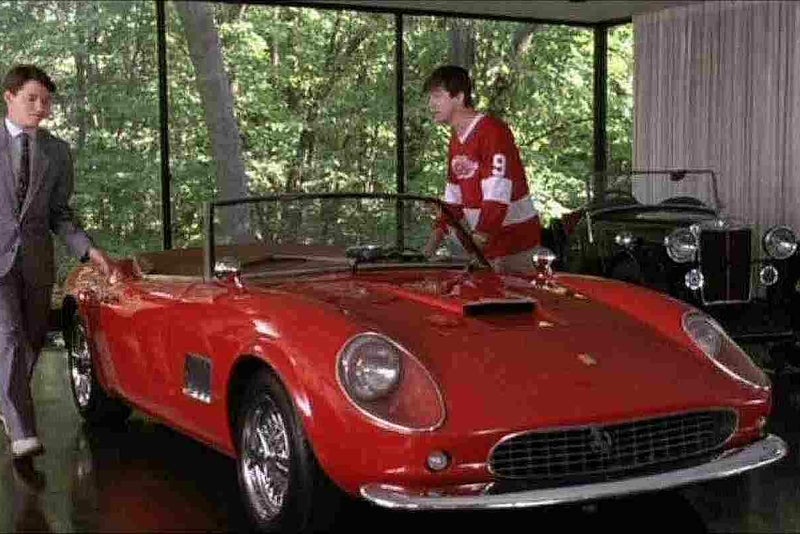


Movie magic and a limited budget are the culprits of this Ferrari imposter. A “replicar” built to resemble a 1961 Ferrari 250 GT California—which cost around $300,000 at the time—it's an amalgam of parts, including a steel-tube subframe, a Ford-sourced small-block V-8, and Ferrari-inspired fiberglass bodywork and emblems.
You can rest easy knowing that a real Ferrari was not “killed” in that infamous garage scene.
Instead of a Ferrari, you have a 1985 Modena GT Spyder California. Three replicas were made for filming, one used for most of the movie, a second for stunts and ultimately the car that rolls backward out of the glass garage, and a third for other shots. Two of them went up for auction in this century through Mecum, one in 2013 garnering $235,000, and a second in 2020, selling for a whopping $407,000.
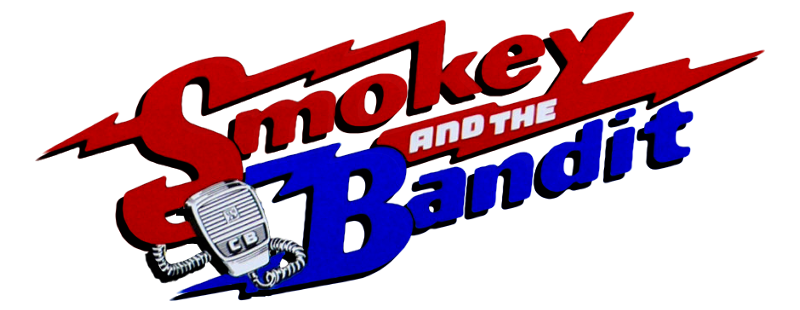
1977 pontiac firebird trans am, smokey and the bandid




The 1977 film “Smokey and the Bandit,” starring Burt Reynolds and Sally Field, was a box office success that would lead to a trilogy of films and several spinoffs. But what many people remember most about the movie isn’t the acting, but the featured car.
The 1977 Pontiac Firebird Trans AM, complete with gold-accented black paint and a huge spread-winged firebird graphic on the hood, roared its way to fame from the first frames in which it was seen.

1980 ferrari 308 gts, magnum p.i.




Most may recognize this model car as the Tom Selleck-driven Ferrari 308 in the hit television show Magnum P.I. Thomas Magnum (Tom Selleck) drove this sweet ride around Oahu for eight whole seasons from 1980 to 1988.
After the shooting was finished, the production company returned the car to Ferrari, which repainted it and sold it as a "demo" car to its first owner in 1986. The current owner bought the car in 1989.
In Ferrari's nomenclature the "308" means that it is powered by a 3.0-liter V8 engine, in this case, one that was then rated at 232 horsepower. The GTS means that it a GT Spyder, so the roof comes off. The lower-case "i" suffix refers to the Bosch K-Jetronic fuel injection that replaced the original carburetors and the QV indicates that it is a Quattrovalvole, or four-valve-per-cylinder engine.
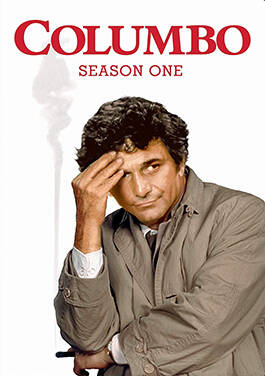
1959 peugeot 403 cabriolet, columbo




It's a 1959 Peugeot convertible, Model 403. Only 504 were produced in France, and Falk's production company owns two (the second is used as a backup car). Despite their dilapidated appearance, the cars are treated with kid gloves. The Peugeot 403 was already well off car lots by the time it became known as Columbo's car. Only manufactured from 1955-1966, it was removed from assembly lines five years before Columbo came on air. By that time, it's likely these cars were already beginning to look a little well-worn if you did see one on the streets, which you could consider adds a layer of historical accuracy to the show. The car was the closest thing the series had to a regular supporting player. It would appear in most of the episodes. Twice the car was involved in accidents: a fender-bender at the beginning of A Matter of Honor and a spectacular collision with speeding police cars in Make me a perfect Murder.
After Columbo ended its NBC run, Falk remained convinced that the car was safely stored on the Universal backlot where he first recognized the automobile that must belong to Lieutenant Columbo. When ABC announced plans to revive Columbo in 1988, Link discovered that Universal had sold the car. Parties in Florida and San Diego claimed to have the original Peugeot. The car was found in Ohio.

1971 plumouth valiant, duel




Duel first aired in 1971 as a television thriller film directed by Steven Spielberg in his film directing debut and written by Richard Matheson, it was later turned into a full-length theatrical. It stars Dennis Weaver as a terrified motorist stalked on a remote and lonely road by the mostly unseen driver of a mysterious tanker truck.
The original release featured a 1970 Plymouth Valiant with a 318 V8 engine and "Plymouth" spelled out in block letters across the hood. A 1971 Valiant with a 225 Slant Six was also used during filming. When the film was released in theatres and scenes were added, a 1972 model with a 225 Slant Six was added, with the "Plymouth" name on the hood as one emblem.
The Valiant's red color was intentional; Spielberg did not care what kind of car was used in the film, but wanted it to be red to enable the vehicle to stand out in the wide shots of the desert highway.
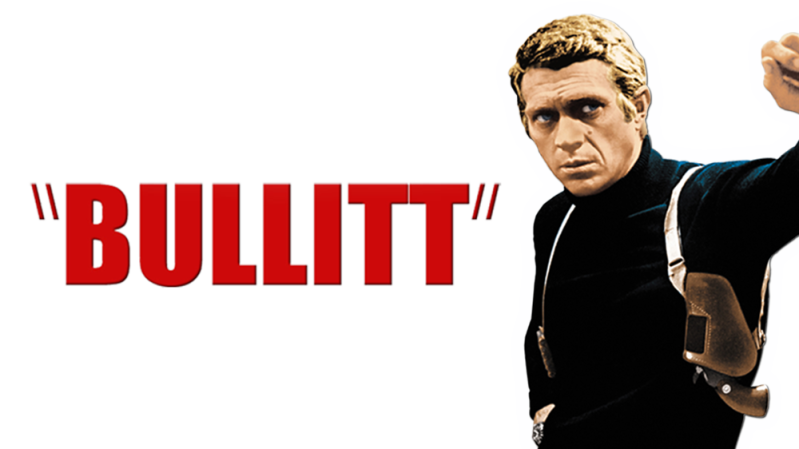
1968 ford mustang fastback, bullit
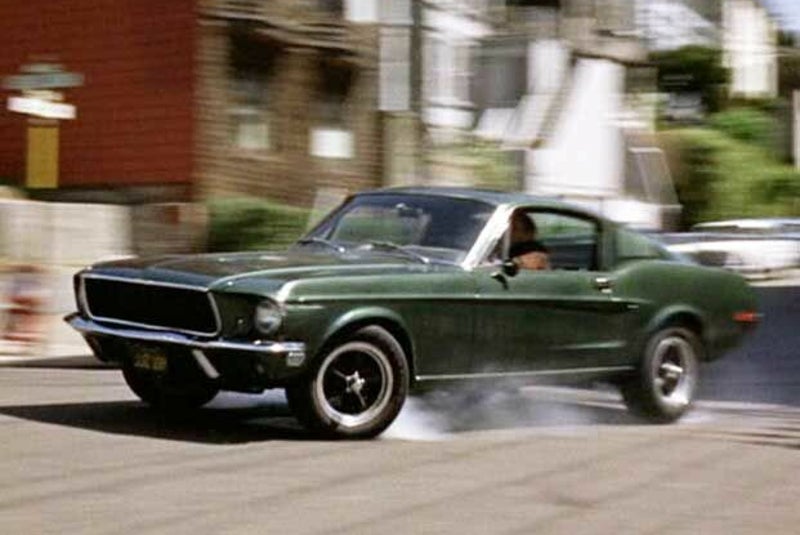



Without the cars, the 1968 film “Bullitt,” starring Steve McQueen, would have been, well … nothing. Car chases define the action-packed classic, and the deep emerald green1968 Ford Mustang Fastbackwas the “hero car” of the film. The car was featured in a famous car chase scene in which the drivers, withMcQueen himself at the wheelin many shots, screeched around the streets of San Francisco.

1985 delorean dmc-12 time machine


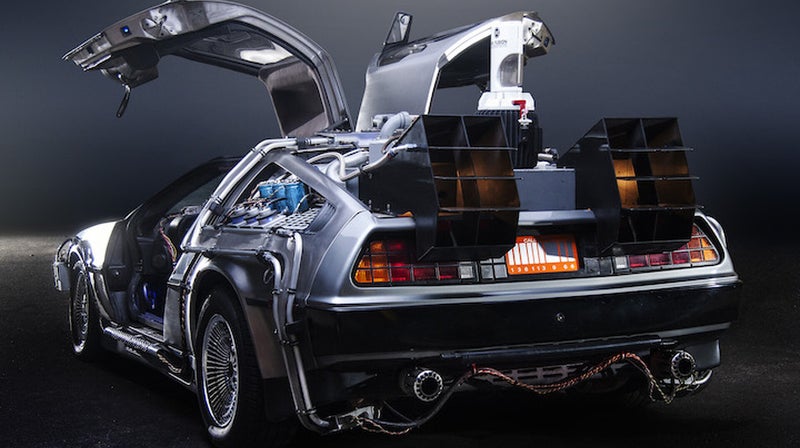

In the Back to the Future franchise, the DeLorean time machine is a time travel device made by retrofitting a DMC DeLorean vehicle with a flux capacitor. The car requires 1.21 gigawatts of power and needs to travel 88 miles per hour (142 km/h) to initiate time travel.
Universal Studios special effects department built three main DeLorean time machines for the movie Back to the Future. The film's producers characterized the DeLoreans with three names: the A car, B car, and C car. The "A" car, also known as the Hero car, was the most detailed and utilized vehicle during production. The "B" car, also known as the Stunt Car used in all three movies, was mainly used for stunts. After purposely being struck by a train during production, the car was left as a pile of rubble. The "C" car was used for interior footage and was torn apart so the camera could fit inside the car. The vehicle was left at Universal Studios Hollywood. There were three extra DeLoreans used through the production of the sequels. The fiberglass car used on special effects was reportedly destroyed.
Had the 1985 film “Back to the Future” been made a few years earlier, the DeLorean Motor Company may have survived its infancy. Sadly, the upstart automaker went bankrupt in 1982.
Fortunately for the maker of the unique gull-wing doored, stainless-steel-bodied sports car, theDeLorean DMC-12, franchise’s producers thought it was the perfect starting point for their now iconic time machine.
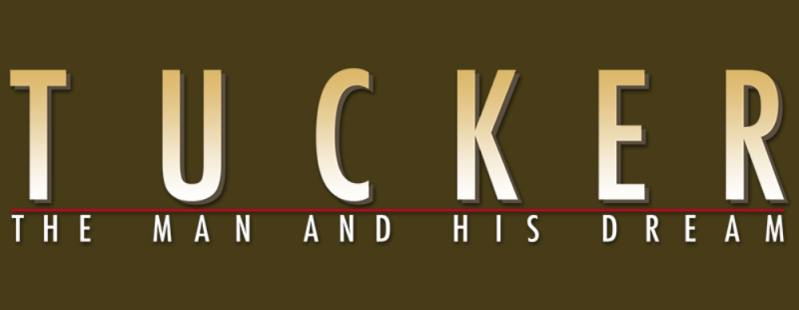
1948 tucker 48. tucker: the man and his dream


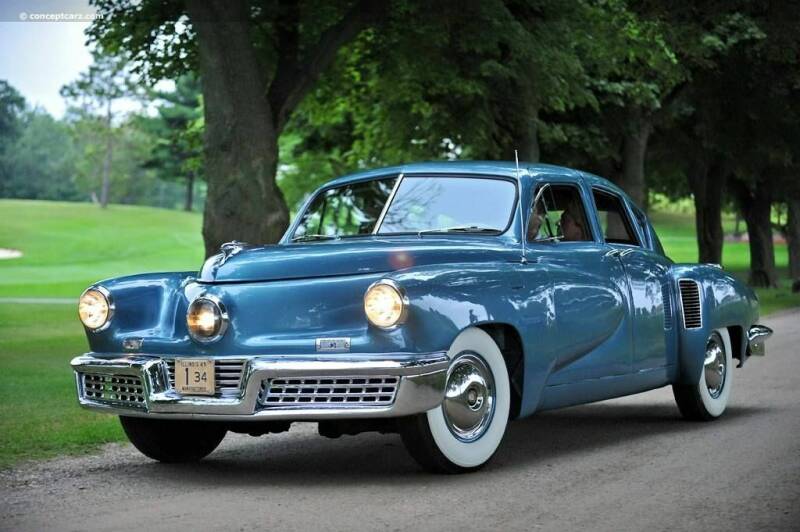

Tucker: The Man and His Dream is a 1988 American biographical comedy-drama film directed by Francis Ford Coppola and starring Jeff Bridges. The film recounts the story of Preston Tucker and his attempt to produce and market the 1948 Tucker Sedan, which was met with scandal between the "Big Three automobile manufacturers" and accusations of stock fraud from the U.S. Securities and Exchange Commission. Joan Allen, Martin Landau, Elias Koteas, Frederic Forrest and Christian Slater appear in supporting roles. Landau won the Golden Globe Award for Best Supporting Actor and was nominated for the Academy Award in the same category.
Although only 50 Tucker Torpedoes were ever produced, 46 of them are still roadworthy and in use today (as of 1988). Many of Tucker's innovations -- aerodynamic styling, padded dash, pop-out windows, seatbelts, fuel injection and disc brakes -- were gradually adopted by Detroit and are found in the cars produced today. Preston Tucker died of lung cancer six years after the trial. The Tucker 48 is often referred to as its original name, the "Tucker Torpedo". This is actually incorrect; the name "Torpedo" was never used in conjunction with the actual production model, and the car's name was officially "Tucker 48".

the batmobiles
The Batmobile is without a doubt one of the most iconic vehicles in superhero history—and movie history, for that matter. It has some pretty humble beginnings, starting out first as a 1956 Oldsmobile, then the infamous Lincoln Futura concept car for the 1966 Batman TV show and subsequent films. From there, the Batmobile started to get more and more outrageous, beginning with Tim Burton’s iteration (arguably the coolest of the “modern” Batmobile renditions), and ending with the most recent tank-like Batmobiles from Christopher Nolan’s trilogy and the newer Batman films featuring Ben Affleck.

batmobile from batman & robin (1997)
The Batmobile from the 1997 film, Batman & Robin, is both one of the longest and most ridiculous Batmobile interpretations. It kind of fits given the ridiculous nature of the film, but it still isn’t the best representation. The design choice here was impractical: it had an open cockpit and a singular seat, a pair of gigantic fins and bright, attention-seeking colors that swirl through the car like a disco ball. Batman can never transport a passenger or prisoner in the car, and it offers him no protection when he’s cruising through Gotham City. Neon, bright blue lights dominate the car and make hiding in shadows (as Batman is usually quite good at) nearly impossible. There was simply no realism that went into the construction of this car.
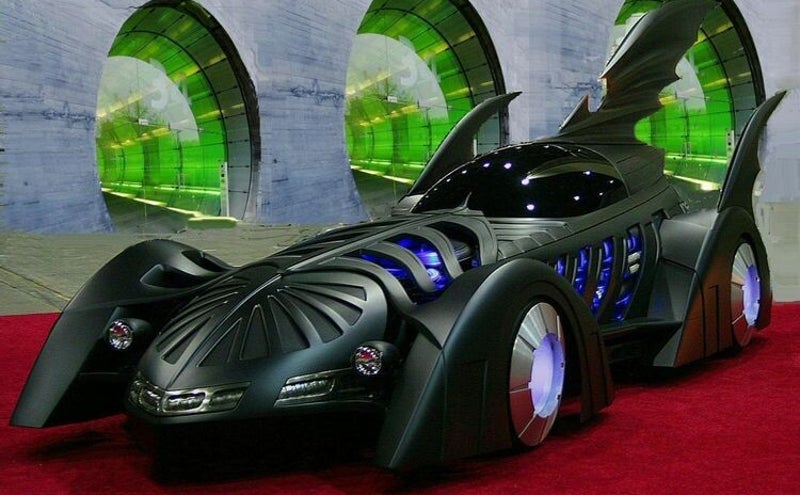
batmobile from batman forever (1995)
Batman Forever was a slightly more serious film than the one that followed it (Batman & Robin), but you wouldn’t be able to tell if you just based it on the Batmobiles.
This one is arguably even more cartoony than the previous Batmobile, as many of the flashy design elements are on display, fusing bright lights, a ridiculously big fin (which can split in two), and the Bat-symbol emblazoned on the tires.
Production designer Barbara Ling outdid herself by throwing in a few extra neon flashes like the jets on the bottom of the car (allowing the car to shoot Bat-grappling ropes and drive diagonally), and non-rotating, brightly lit hubcaps. Finally, Ling added the ribs, in a failed attempt to make the Batmobile look more “organic.”

batmobile from batman (1966)
One of the most famous (and most sleek) Batmobiles in Batman’s arsenal comes from the 1966 TV show, starring Adam West. The vehicle created for the 1966 live-action show (and subsequent film) has an interesting history. The basis for the ’66 rendition was a real-world car: the Lincoln Futura concept car, which was built in 1955 after its designer came across a shark while scuba diving. Today, the car would cost $2.2 million, which means it never got off the ground—until ABC fast-tracked production, and car builder George Barris, who already possessed the Futura, transformed it into the Batmobile. The sleek design and color palette make it look like one of the fastest Batmobiles to date: a muscle car plastered with Bat symbols and a cool color scheme.

batman: the animated series (1992) live action
This Batmobile was largely inspired by Tim Burton’s 1989 film reboot. Batman: The Animated Series premiered just three months after Burton’s last Batman adventure, Batman Returns.
The Batmobile from the cartoon bears a striking resemblance to the movie’s dramatic car, including its shield mode, which it would be locked into when Batman had to go crusading on foot.
The animated car combined the show’s ‘30s and ‘40s retro designs with the exaggerations of cartoon formatting, producing a long, striking vehicle that is both curvy and boxy at the same time. This is the way that a cartoon Batmobile should be done.

the tumbler from batman begins (2005)
Initially, Christopher Nolan did not want to include a Batmobile, as his trilogy was supposed to be darker and more realistic. But Warner Bros. Insisted, so Nolan vowed to not only make the car distinctly his own, but to intimately tie the Batmobile to Batman’s suit and gadgets. The result is the Tumbler, a massive battle tank/futuristic car. It has armor plating that gives Batman more protection than he’d ever need (except from missiles, as the Joker proved). It has a jumping feature, explained as part of its original bridge-making functionality for the military, allowing him to fly across rooftops. It also has some basis in source material, as Frank Miller’s The Dark Knight Returns featured a massive tank design, too. It also played a big part in influencing the current Batmobile from Batman vs. Superman.
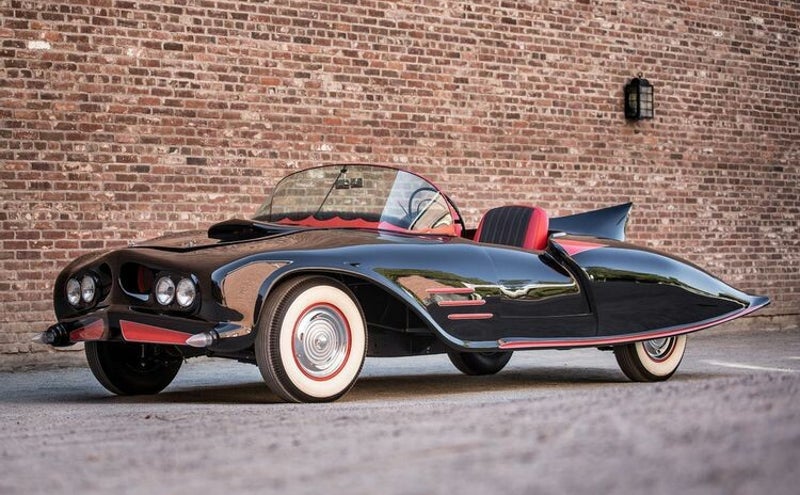
batmobile from 1963
Shortly before the Batmobile starred in the 1966 TV show and subsequent film, there was actually a prior car that was the earliest known, officially licensed Batmobile. This thing looks pretty sweet, too. It was conceived and customized in 1960 by 23-year-old Forrest Robinson, built in his family farm. Robinson completed the car in 1963—two years before the George Barris customization of the 1966 Batmobile started. The “63 Batmobile” is the earliest known car in existence that was sanctioned by a DC Comics licensee, though it never made it to film. It’s biult from a 1956 Oldsmobile 88 frame, with a 324 Rocket engine. In 2014, it debuted at the Sacramento Autorama, America’s longest-running indoor car show, and won first place in hand-built sports cars, ahead of the Shelby Cobra. Later that year it was sold for $137,000 at auction.

batman vs. superman: dawn of justice (2016)
The 2016 iteration of the Batmobile from Batman Vs. Superman: Dawn of Justice, closest resembles the Tumbler from Christopher Nolan’s franchise. It’s an interesting mash-up between the long-hood design of Tim Burton/Joel Schmacher movies and the tank element from The Dark Knight trilogy.
Production designer Patrick Taopoulos built the car in five months (two of them, actually), and said it was surprisingly hard to find tires for it.
They tires they eventually found were from Israel and used on farming trucks, before being re-sculpted and shaved to fit the car. This one comes equipped with twin .50 caliber machine guns, is stealth-capable and protected by anti-ballistics, anti-roll, a shield generator system, jamming signals system, sensor assembly, laser tracking, grappling hook, electromagnetic pulse protection, and ballistic missile defense system.

batman 1989
When Tim Burton was hired to direct the first modern Batman, and a one-off, at that, he decided he wanted to take the character, the city, and his car in an entirely different direction than ever shown on screen before. The result was revolutionary and riveting, especially how the Batmobile turned out. ScreenRant.com rated Burton’s Batmobile the best Batmobile of all time, in any medium.
Production designer Anton Furst took to the challenge: he removed a number of telltale flourishes, like the Bat-mask, while retained others, like the fins.
The molded everything around a brand-new design, with a large jet turbine that dominates the front and rear ends. This car looks fast, sleek, and most importantly, dangerous. It’s remained the foundation of the character’s Batmobiles ever since.

bruce wayne’s mustang from gotham (2018)
While we’re on the topic of Batman, let’s bring this one up. Earlier this year, season 4 of Gotham started with Bruce Wayne’s near-complete transformation into Batman, including the introduction of his very first “Batmobile,” this matte black, sleek Ford Mustang. Or at least that’s what it looks like. Of course, Batman isn’t really Batman yet, so he doesn’t have his array of Bond-like gadgets on the car, or too many toys. Right now, it’s just got the bare essentials for crime-fighting, but it’s definitely a step in the right direction, and I think it looks super cool. It’s a far cry from the tank platform Batmobiles that have appeared in recent movies, and perhaps that’s a good thing.

1982 k.i.t.t. 2000 pontiac firebird trans am


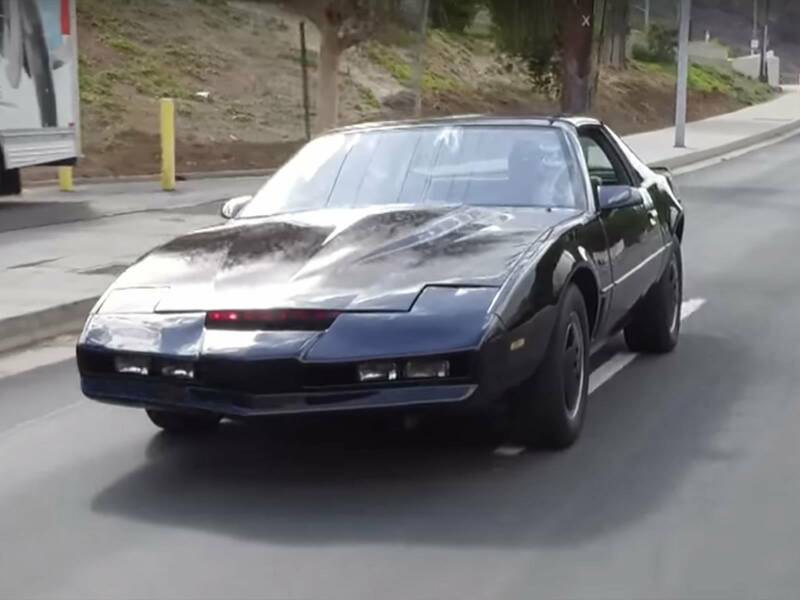

KITT (an acronym for Knight Industries Two Thousand) is a fictional computer that controls the high-tech Knight 2000, a black Pontiac Firebird Trans Am T-top automobile. The voice for KITT was provided by William Daniels, who requested that he not be credited for his work.
In the original series' history, K.I.T.T. was conceived and designed by the late Wilton Knight, a brilliant but eccentric billionaire and the founder of the "Foundation for Law and Government", (commonly shortened to "FLAG") and its parent Knight Industries.
K.I.T.T.'s main cybernetic processor was first installed in a mainframe computer used by the United States government in Washington D.C. However, Wilton saw better use for "him" in the Foundation's crime-fighting crusade and eventually the system was installed in the vehicle. K.I.T.T. was in fact the second vehicle built by Knight Industries with an artificial intelligence. His predecessor was K.A.R.R., the Knight Automated Roving Robot. K.A.R.R. was programmed for self-preservation, but this proved to be dangerous to the Foundation's interests. K.A.R.R. was later deactivated and placed in storage while K.I.T.T. was given to his new operator Michael Knight (the new identity of Michael Long).
20 cars were used during the show's production, but only five survived – two of which are now owned by Huth and Palmgren.

1963 volkswagen beetle model 117 deluxe sunroof sedan, herbie: the love bug




Long before Kit from Knight Rider, we had a sentient car in Herbie. Herbie is never referred to as a Volkswagen in the first film, as all branding had to be removed. But VW was on board for the second film, Herbie Rides Again.
In each of the five films, Herbie appear slightly different and upward of 100 cars were used in all five. Walt Disney Studios built 11 cars for the first Herbie movie, and of those 11 only three are known to exist today. Normally, the interior of this beetle would have been white but for the film they painted it a gray color so it wouldn’t reflect the studio lights.
One of the VWs in the film was outfitted with a Porsche Super 90 engine for extra performance. Herbie #10 resides at the AACA Museum in Hershey, Pennsylvania, if you’re suffering from a different kind of Beetlemania and need a quick fix.

1932 ford coupe, american graffiti



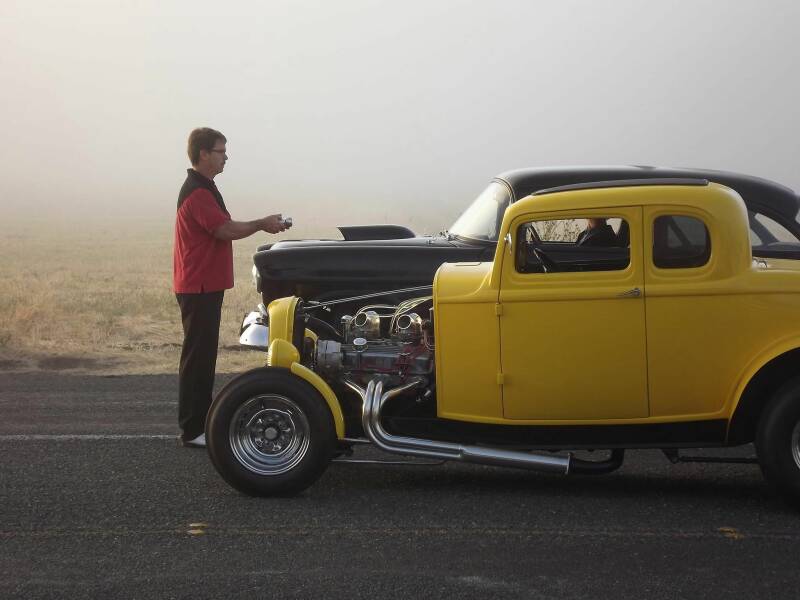
A few years before Star Wars, George Lucas shot American Graffiti, a reflection of his memories of the car culture in California in the 1960s. Besides a cast that included future megastars such as Ron Howard, Harrison Ford, and Richard Dreyfus, the movie had some great hot rods. But only one has become the most recognized Deuce Coupe in the world. The brash Canary yellow '32 Ford highboy is powered by a Chevy 327 V-8, and sits a little tall in the rear for some seriously cool rake. For American Graffiti, George Lucas specifically wanted a ’32 coupe with a chopped top.
When American Graffiti was released in August of 1973, America was longing for simpler times after the social and political upheavals of the Sixties, and the film electrified a nostalgia movement that was already in progress. It also increased recognition of Fifties cars that were not even twenty years old at the time.

1969 mustang john wick
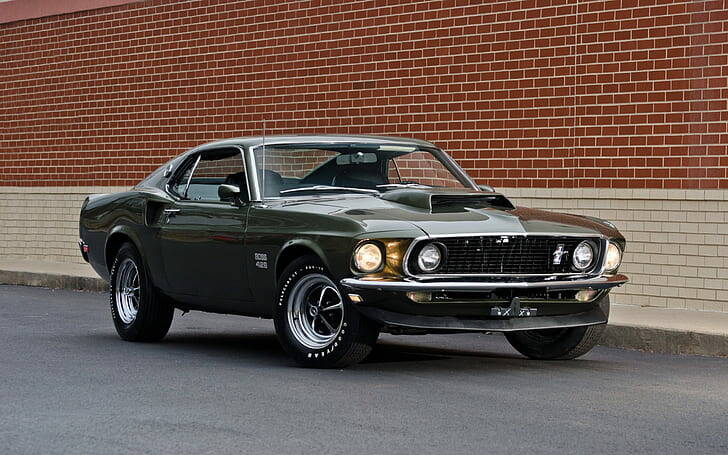



Keanu Reeves's most memorable on-screen vehicle just may be a Los Angeles city bus. But his coolest is the Mustang in the movie he made 20 years later, John Wick. The Mustang in question is identified in the movie as possibly being a "Boss 429," but that's not the case. A real Boss '9 is rare and highly collectable—one sold at auction back in 2015 for $550,000. It's likely the film crew used a '69 Mustang Mach 1 with either a 390 V-8 or a 428. Both are plenty potent for on-screen antics and look absolutely badass.

1974 bluesmobile dodge monaco, the blues brothers




The Bluesmobile may not be the Batmobile, but this decommissioned Mount Prospect, Illinois, police cruiser is just as recognizable as Jake and Elwood Blues’ outfits. Born from Saturday Night Live veterans Dan Aykroyd and John Belushi, the sketch resulted in two movies. The Dodge Monaco version was only used in first film; the sequel saw a 1990 Ford LTD Crown Victoria as the Bluesmobile’s latest incarnation.
The film utilized 13 different cars as the Bluesmobile, all of which were former California Highway Department patrol cars made up to look like Mount Prospect patrol cars. Some of the cars were modified for speed, others for jumps or high-performance maneuvers, depending on the scene. More than 60 old police cars were purchased and used for the film’s many chase scenes

1958 plymouth fury christine


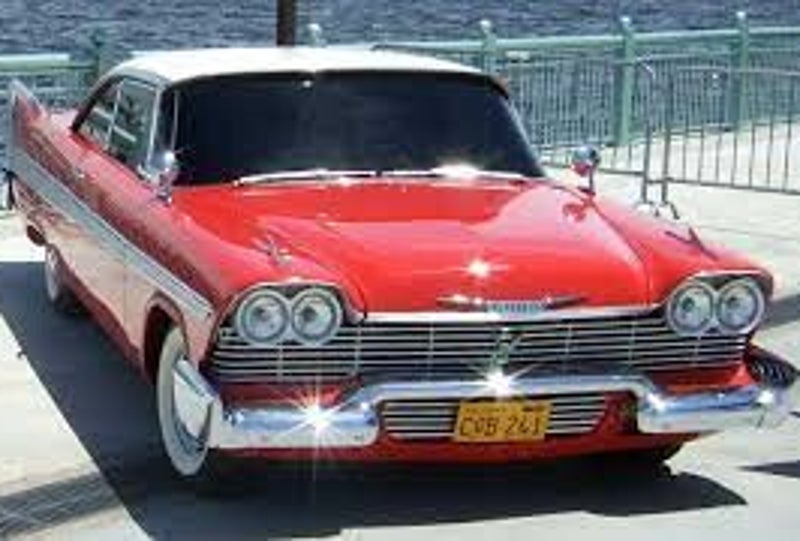

How could we leave a horror movie centered around a 1958 Plymouth Fury off the list? Stephen King was so popular at the time and had enough clout that the film went into production before the book was even published. Anywhere between 23 and 28 cars were used in the film (sources vary), and not all of them were Furys. Columbia Pictures placed ads across the country looking to buy Belvederes and Savoys, too. The majority of the cars were used on screen and the rest were used for spare parts.
The illusion of Christine’s ability to regenerate herself was created using hydraulic pumps located inside the car that were attached to the sides of a plastic-paneled body double. The pumps then sucked in the sides to create a damaged version of the car, and then the film was reversed. Some tricky special effects for 1983.

1992 ford explorer xlt un46 jurassic park
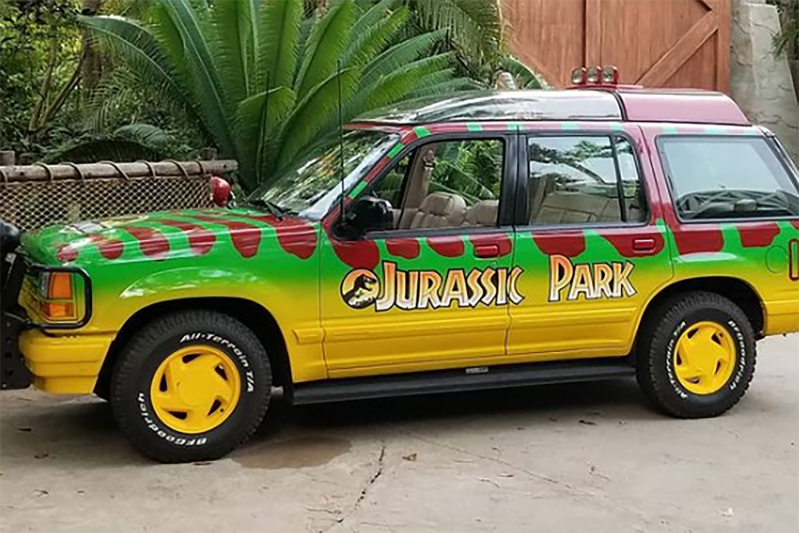



Though the cars appear to be Jeeps, they’re really Ford Explorers, and a solid portion of the movie takes place in and around them. While these Touring Vehicles didn’t see much off-roading, they're an integral part of the Jurassic Park experience—before the dinos got loose and the characters realized they were stuck on Isla Nublar, that is.
Customized by Hollywood pro George Barris, many fans have been inspired to replicate the car, taking years to painstakingly re-create the ’90s icons. The cars were modified to give the illusion of automation by hiding the driver in the trunk, where they watched a small TV that was fed outside images via two cameras.

1976 mirthmobile amc pacer wayne’s world 1 and 2
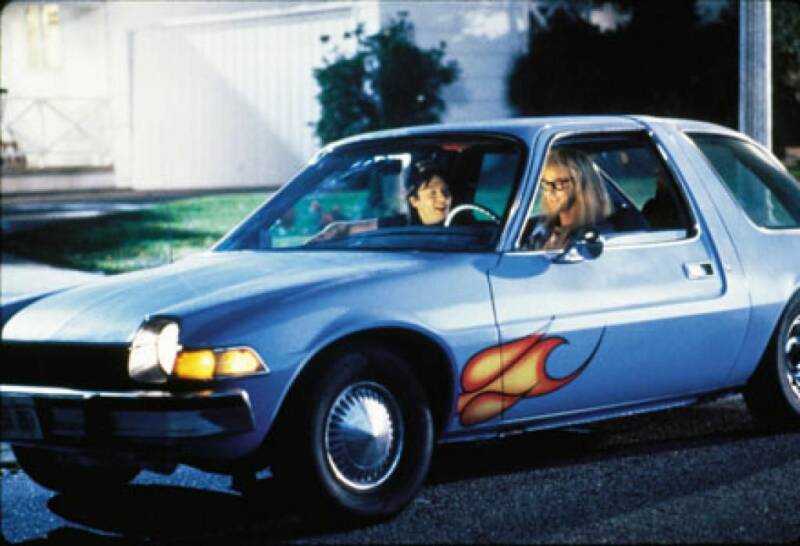



The Mirthmobile: the perfect get-around for a flame-throwing, headbanging, licorice-loving guy or gal. While Wayne's World resurrected the Pacer (and Queen’s “Bohemian Rhapsody,”), it’s widely considered to be one of the ugliest cars ever made. Intending to break ground in the compact-car category at the time, its main selling point was its unusual width—it was as wide as a midsize car.
It’s typical for movies to have multiple versions of the same car, but it’s believed that only one Pacer was used for the cast’s trips to Stan Mikita’s Donuts. This Pacer has the larger 4.2-liter I-6 motor mated to a three-speed auto transmission. The hatchback was modified for the film inside and out, including a hole in the roof allowing for the installation of the red-rope licorice dispenser.

1976 ford gran torino, the striped tomato, starsky & hutch
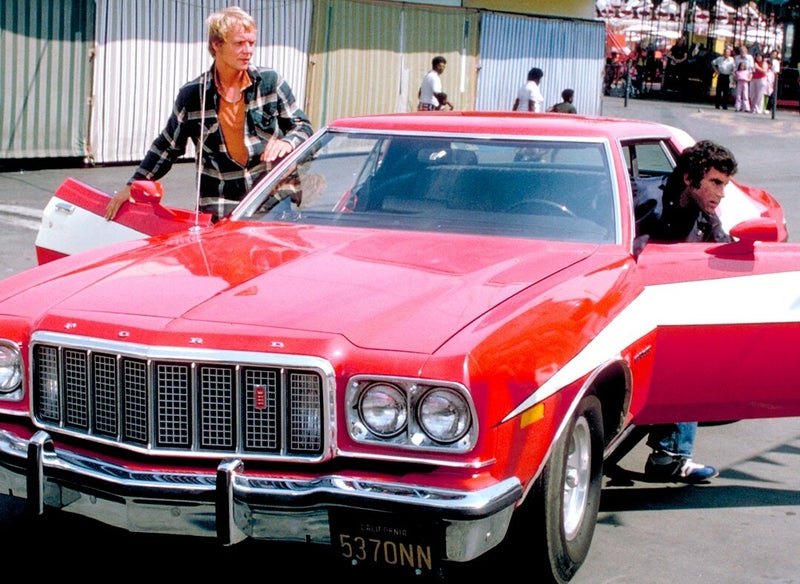

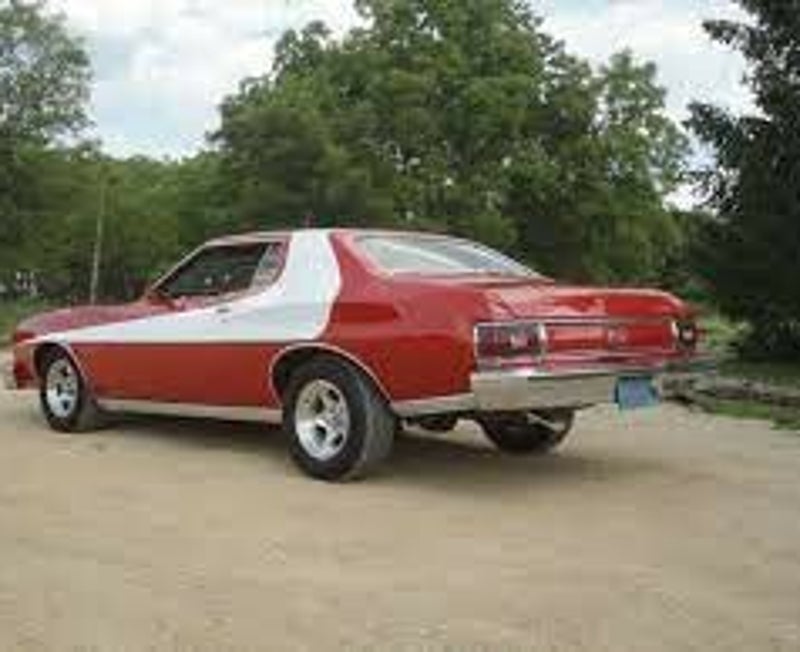

Ben Stiller and Owen Wilson were tasked with reviving the personas of Starsky and Hutch, two ’70s police detectives with a badass 1976 Gran Torino. Due to the popularity of the TV show, Ford produced a run of roughly 1,300 Starsky & Hutch replica Gran Torinos. None of the original Torinos were available to use as a basis for the movie, but one of the special-edition replicas was used as a template, along with tapes of show, old photos, and model cars.
The movie required numerous cars for the chase scenes and peel-outs, and only two “hero” cars from the film were left intact. One a 1974 and the other a ’76 model, they were built by Mike Walsh’s Premiere Studio Rentals and were identical despite their two year age difference.
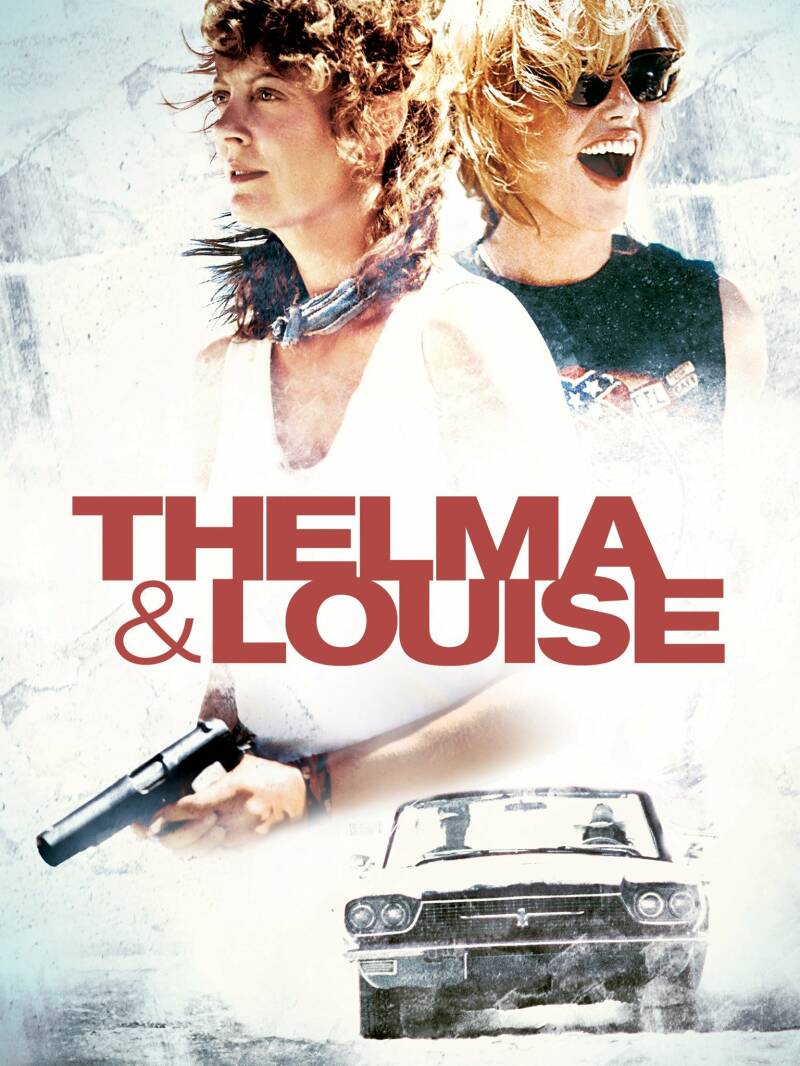
1966 ford thunderbird, thelma & louise
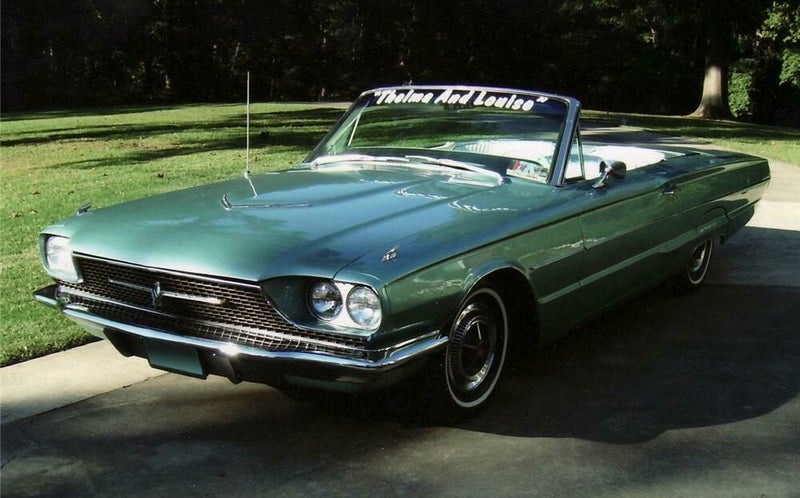



Like any classic outlaw, these two ladies rode in style in a 1966 Ford T-Bird. The car was chosen simply for its practicality for shooting movies: It’s open and easy to shoot the actors, and the backseat allows for Thelma and Louise to travel with other characters. A total of five cars were used in the movie: one “hero” car used solely for exterior shots, one camera car, two stunt cars, and one for backup. They didn’t receive any customization that is customary for a movie car, remaining the same as they would’ve been straight off the showroom floor. Since being purchased from Metro MGM Movies in 1991, one car was sold at auction in 2008 and earned $71,500—but that could have been for the Brad Pitt and Geena Davis signatures adorning the armrest and sun visor, respectively.

1967 shelby gt500 eleanor, gone in 60 seconds

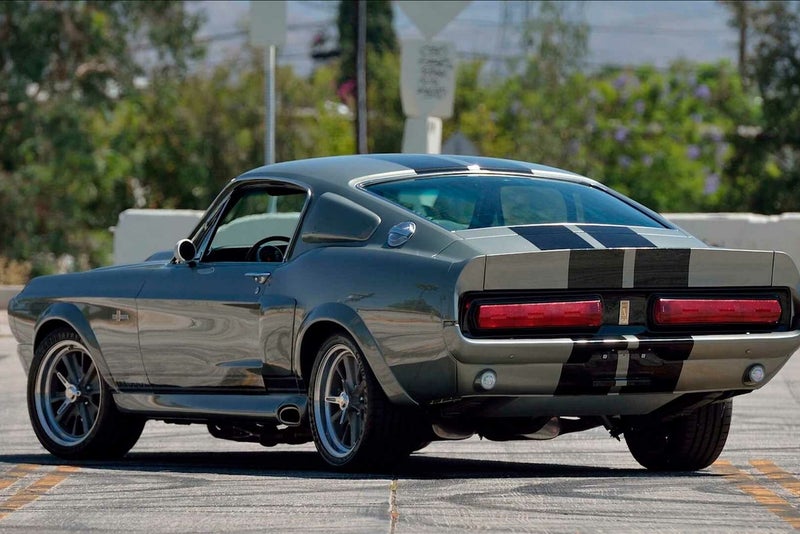


Named Eleanor after the 1974 original movie, this Dupont Pepper Grey 1967 Ford Mustang fastback is depicted as a Shelby GT500. Eleven of the fictional Mustangs were created for the movie, with only three of them being working cars and two were ultimately destroyed during filming.
Though not an original Shelby, its power comes from a 351 Ford V-8 crate engine, rated at 400 horsepower. The car features central-mounted driving lights, pumped fender flares, a four-speed manual transmission, lowered suspension with coilovers, 17-inch wheels with Goodyear F1 tires, and a faux nitrous kit. A primary “beauty” car for the film was sold through Mecum in 2013 for a staggering $1 million, but you can purchase your very own licensed Eleanor replica through Fusion Motor Company.

1973 chevrolet chevelle malibu, drive




In preparation for this 2011 car-centric movie, Ryan Gosling restored the 1973 Chevy his character (solely named Driver) drives in the film. While this car may not seem like the ideal choice for a getaway driver, when director Nicolas Winding Refn told Gosling he could pick out his character’s personal car, he picked out the Chevelle from a junkyard. It’s technically a Chevelle with the Malibu trim option–the Malibu didn’t become a distinct vehicle until the ’77 production year.
Remember Driver’s fondness for stock-car racing? Well, it just so happens that the Chevelle was commonly used in the sport from 1973 to ’83, becoming one of the winningest cars in NASCAR history.

1969 dodge charger, general lee, the dukes of hazzard



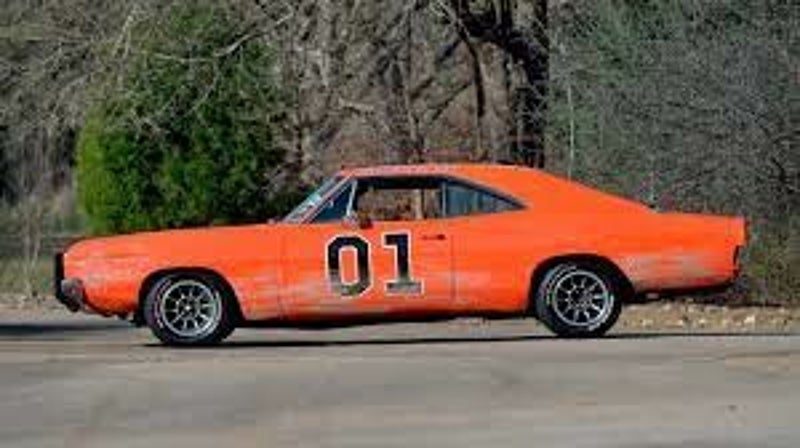
Unlike Starsky & Hutch, which is set in the same time period as the TV show, this movie is set in present day. At the beginning of the movie, the car is a faded orange with a hand-painted “01,” black steel wheels, a standard front bumper, and no Confederate flag on the roof. Halfway through the film, The General undergoes a transformation after being vandalized: Cooter repaints it a bright “Hemi” orange, adds ten-spoke turbine wheels, the octagonal “01,” a black grille guard, the flag, a “Dixie” horn, and the “General Lee” above the door openings.
Reportedly, two dozen 1968–70 Chargers were used for the film, though most of them didn’t survive the stunt-packed scenes. Again separating itself from the show, the movie cars used aftermarket graphics kits, but overall they vary little from the original General Lees. One of the TV cars did make an appearance in the film as a close-up car. It was used for a few scenes and then sent back to Warner Bros.
In the aftermath of the 2015 Charleston, South Carolina shooting deaths and the reignited resistance to the Confederate flag, Warner Bros. announced it would stop production of the General Lee toy cars.

2008 audi r8, iron man


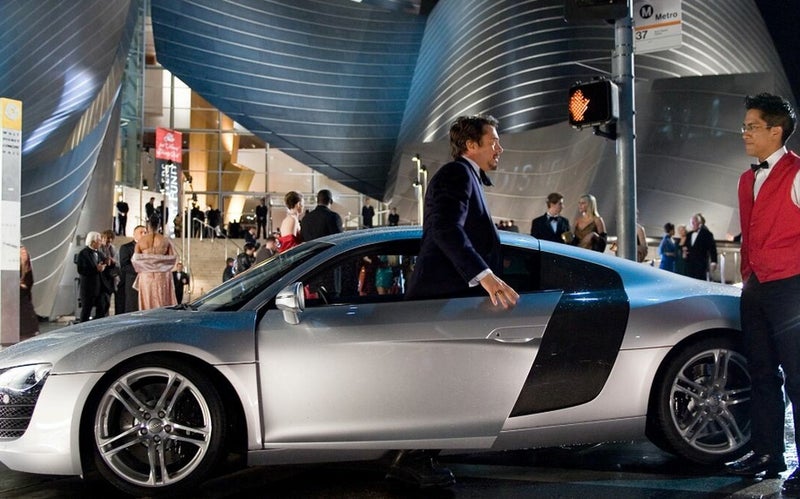

Tony Stark's 2008 R8 has a mid-mounted, 420-hp, 4.2-liter V-8 engine, goes 62 mph in 4.6 seconds, and features and aluminum and magnesium space frame. Audi was able to convince director Jon Favreau to include the car in the first installment of the Iron Man franchise, taking its screen time so seriously as to create a microsite devoted solely to the cars used in the film.
It was so successful that Audis were included in future films. During the final battle, originally there was going to be a sequence where Tony, in the suit, drives an R8 that would crash into his adversary’s legs and then flip over, after which Iron Man would split the car in half and then jump out to fight. The car was so well-built, clung to the road, and wouldn’t break that the scene had to be rewritten. After the movie, the Audi R8 was known as the “car Iron Man drives,” sitting in his garage alongside a Shelby Cobra, Saleen S7, Tesla Roadster, and a 1932 Ford Flathead Roadster.

1967 austin mini cooper s 1275, the italian job
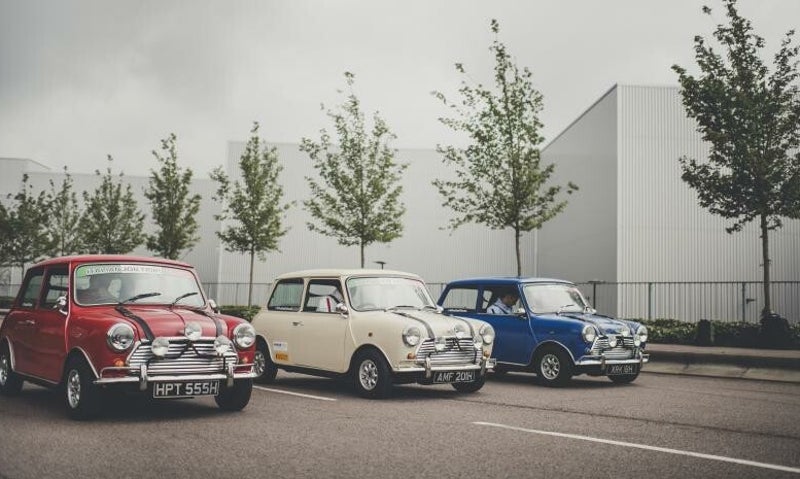



Although the Minis in the 2003 remake are gorgeous, they don’t even come close to the models from the ’69 film. The British Motor Corporation, the maker of the car, refused to donate any cars to the film, selling the production crew six Minis at trade price (leading 30 more to be purchased at retail). As uncooperative as BMC was, screenwriter Troy Kennedy Martin refused to trade out the vehicles for one of the world’s most-famous chase scenes.
The head of Fiat, Gianni Agnelli, was enthusiastic about the film, offering to donate all the cars they needed—hopefully Fiat 500s in place of the Minis—and happily assisting the production. He allowed the crew to shoot and practice on the company’s private premises and gave them three Ferrari Dinos for the Mafia to drive. The red, white, and blue getaway cars feature a four-cylinder, 75-hp engine, with a top speed of 97 mph and an improbability of them toting more than 300 pounds of gold.
While it’s a film predominantly about cars and driving, Michael Caine could not drive at the time and is never seen driving a car in the film.

2007 chevrolet camaro replica, transformers




In the first film of the Transformers series, we’re introduced to Bumblebee as an old 1977 second-generation Chevy Camaro. He eventually converts into a fifth-generation, but remember this is 2007 and it’s two whole years before the car would go into production. A replica would need to be made, slick enough to fool viewers and do the toy line justice. The car needed to be able to survive the rigors of filming a Michael Bay movie, so body panels made from the same molds as the 2006 Camaro Concept were used.
Two Bumblebees were made by Saleen, which built the Cobras in xXx: State of the Union, out of two 5.7L, LS1-powered Pontiac GTOs. Talk about creating buzz for the forthcoming Camaros.

2006 cars, pixar animation


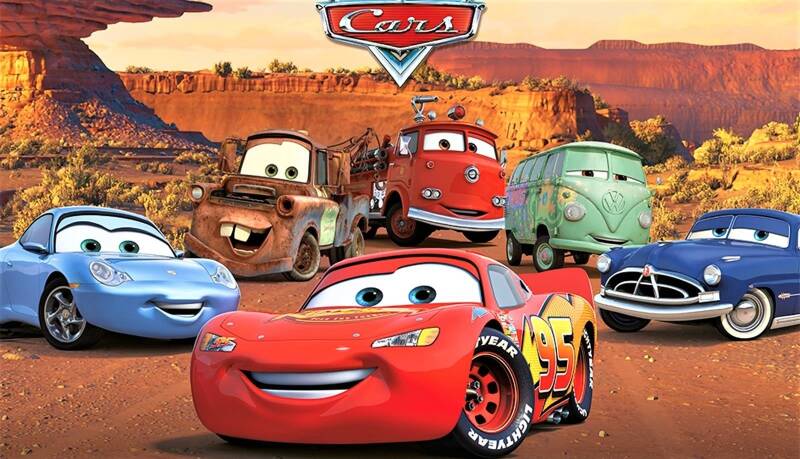

Cars is a 2006 American animated sports comedy film produced by Pixar Animation Studios for Walt Disney Pictures.
Set in a world populated entirely by anthropomorphic vehicles, the film follows a young self-obsessed racecar named Lightning McQueen who, on the way to the most important race of his life, becomes stranded in a forgotten town along U.S. Route 66 called Radiator Springs, where he learns about friendship and begins to reevaluate his priorities.
The success of Cars launched a multimedia franchise, which includes two sequels: Cars 2 (2011) and Cars 3 (2017), as well as two spin-off films produced by Disneytoon Studios: Planes (2013) and Planes: Fire and Rescue (2014).





Create Your Own Website With JouwWeb